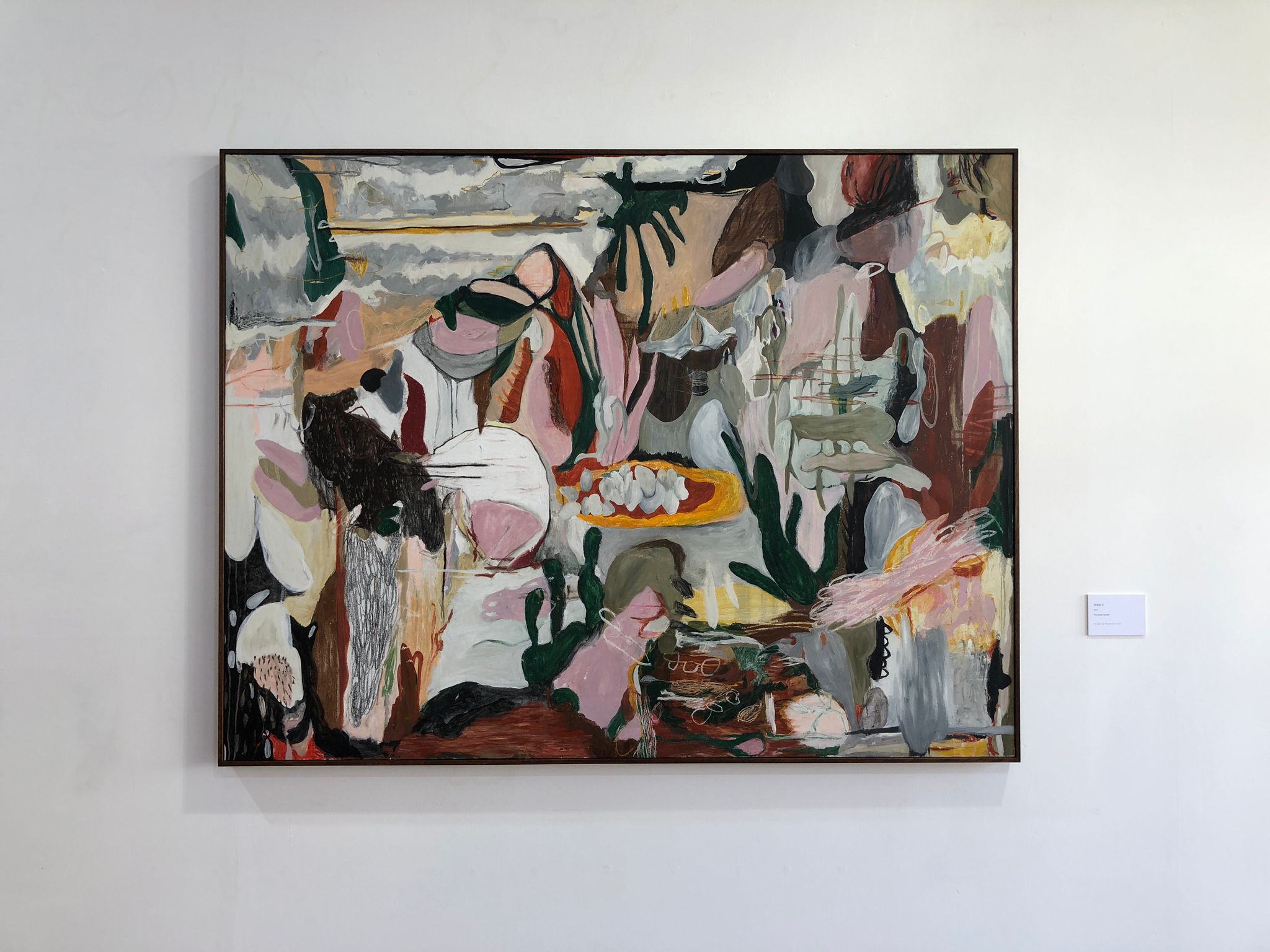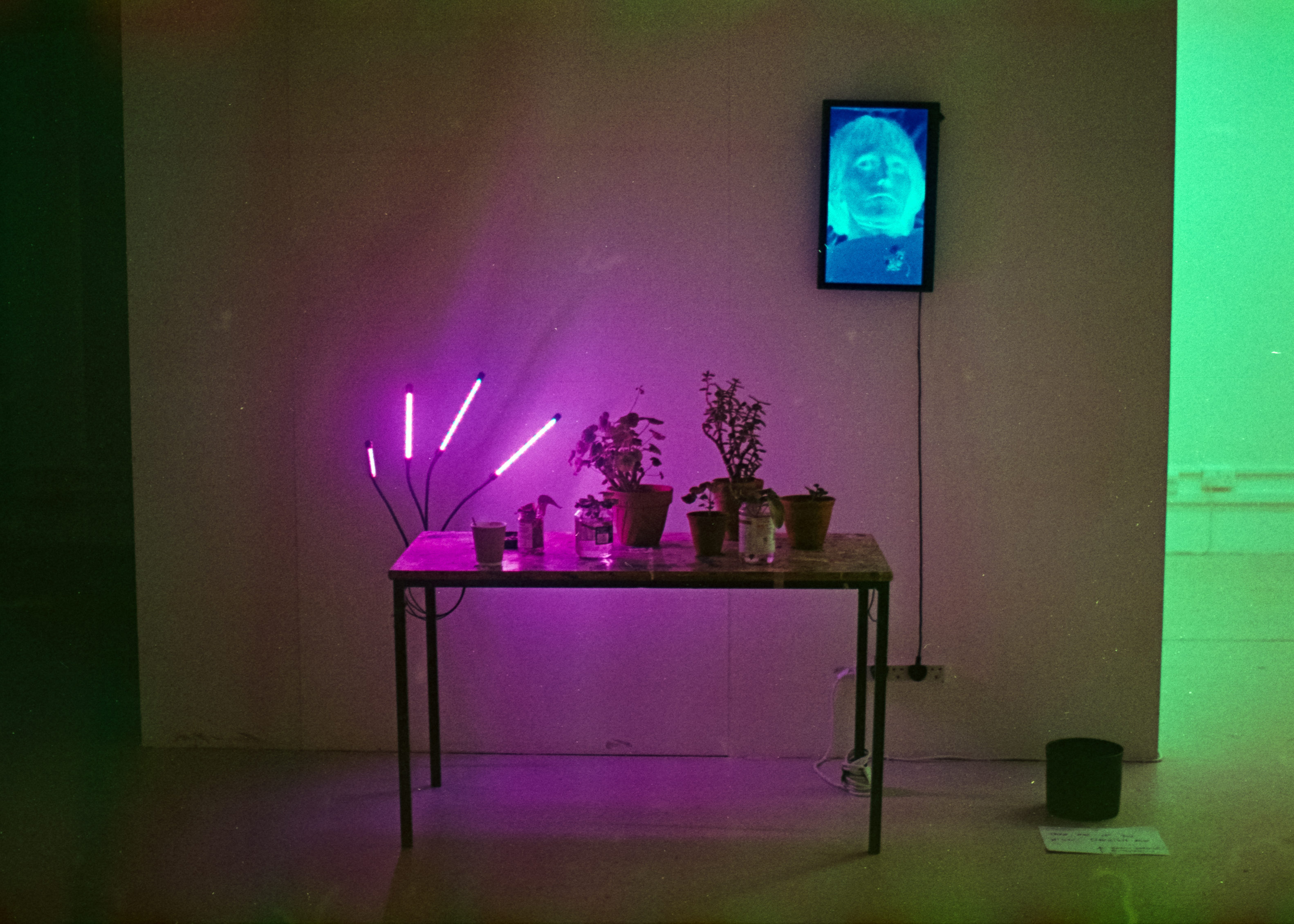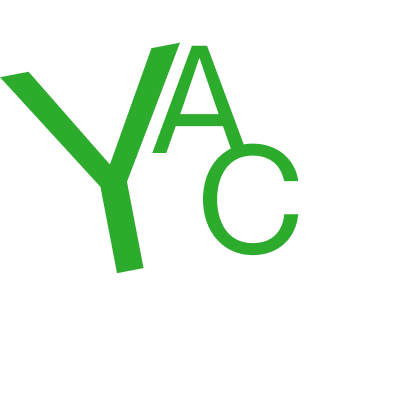Fernanda Galvão
Interview by Olivia Bright
-
Published in October 2021
-
Olivia Bright spoke to artist Fernanda Galvão who is featured in the exhibition Re-Rooting, which is part of Folkestone Fringe, and runs between 7-30 October 2021.
Re-Rooting is a multi-disciplinary exhibition unearthing the psychological and political undergrowth behind connections to 'the land'. Inspired by the rising popularity of gardening during the Covid-19 pandemic, the show examines how artists relate to nature as a means of personal and socio-political healing.
-

Thank you so much for this interview. I thought it’d be nice to discuss your painting Ovitos II within Re-Rooting’s themes and ideas, then talk about your practice a little more deeply.
Why don’t we kick off with you introducing yourself and your work to the readers?
Thank you for talking with me! So I'm Brazilian, I live and work in São Paolo, and I create paintings, objects, installations and sculptures. For the past few years, I have focussed on painting. At the moment I’m actually working on a film, but I think regardless of the medium, fiction and science fiction surround my work and that's why I keep producing. It starts with them. For me, fiction and science fiction are a way of blending creativity with scientific methods. I have an idea, and then develop a hypothesis to try to prove this imagined reality.
That’s interesting. Are there any themes or ideas you keep returning to?
I like to imagine places with no people.
Ooh!
Yeah. Plenty of plants but no humans. I keep imagining these atmospheres and try to recreate them in paintings. Sometimes they’re more watery or airy or dry...but the process begins with me imagining an atmosphere and working out how to recreate it.
A place with no people: is that a paradise or an apocalypse?
A bit of both. I think I try to create my own type of nature, you know, I mean, it's somewhere else. I keep looking at nature to think of non-real situations.
This is a convenient segue for me to introduce Re-Rooting actually. The exhibition examines artists’ relationships with land in terms of socio-political and personal forms of healing. It positions gardening as an artistic practice so I find it interesting that you describe your work as ‘creating a new type of nature’- to a certain extent, that’s what a gardener does. Are you a gardener? Or is that something you leave for your canvases?
I’m more of a gardener in a metaphorical way. My works take like 1-3 months to produce. They’re a really slow process, one I’d compare to planting a seed, watching it grow, sometimes watering, sometimes cutting it back...and that's how I see my paintings: it's really slow and I have to keep looking, adding, erasing. I have a ‘pictorial biome’, or a vocabulary of gestures, which I’m building up. Random gestures become symbols which are carried into future works.
Kind of like a nursery of plants, constantly being propagated and recycled. I hadn’t considered it before, but this process has such a striking relationship with Amber Sherratt’s installation @mama.gardened, positioned opposite your painting in Re-Rooting. She invites the audience to take cuttings from her deceased mother’s houseplants, to continue her legacy and draw attention to the care required to sustain life.
I love that you’re cultivating this vocabulary of vegetal gestures. Going back to your interest in science fiction, it reminds me of post-humanist authors like Anna Tsing and Donna Haraway who advocate for building human/non-human relationships. What are you reading or watching that inspires you?
I just finished two Ursula Le Guin novels, which I enjoyed so much! She's a feminist science fiction writer and I love how she reflects her characters’ psychological states within the landscape. I was really inspired by The Left Hand of Solitude. There’s a passage with snow where she describes loneliness, which I’ll never forget.

Well I think emotions play a big role in how we form memories of places. We leave psychological residue of ourselves within our experiences of landscapes, which can be extremely evocative. What's your relationship with land more generally? Did you grow up in the city or countryside?
I grew up in São Paulo, but my family has a place in the interior, where I go hiking every day. Right in the middle of the forest with a lake and I go there to think about palettes, compositions and textures. The outdoors is really important to me but I only realised how much so when I was in college. I was doing my thesis on gardens and the body. I started to research biological cells, tissue cells, cancer cells and that’s when something happened: I found the landscape itself, right there in those cells. I tell you, look up an image of ‘histology’ on Google and you’re going to see the whole universe, an enormous landscape right there in those tiny cells of bodily tissue. It’s so similar. The realisation that it was within us, as much as we are within it, was a really important moment. So I’d say more generally, I have a strong connection to landscapes.
How amazing to operate on macro and micro terms at the same time. This was something really important to us when curating Re-Rooting. We considered your work, Ovitos II, as an example of the macro - partly because of its name! Thinking about ‘eggs’ as a symbol of fertility and new life in contrast to Bolsanaro’s destructive regime of deforestation and industrialisation, represented by the swathes of grey…...did we get it right?
The title is actually a joke.
Oh.
Kind of. Because actually, the Portuguese word for eggs is ‘ovos’, and ‘ovitos’ is the name of a snack which is really bad for your health. Super processed. Kind of like a bag of peanuts covered in candy eggshells....
….Well...bang goes our theory!
I mean there’s a lot of things popping out and giving birth to each other and my process is very organic, with one idea growing into the next, but there’s always a layer of humour somewhere. Even when it's melancholic or if I'm talking about the end of the world, you’ve got to be able to laugh!
Well perhaps we were half-way there, with it being a double-entendre...how political is the painting?
I mean, I think my work is not a political statement, but of course there’s no way of talking about landscape and nature and not talk about what's happening.
Yeah, environmentalism seems like an important issue within Ovitos II, especially now that I know it depicts ‘a place with no people’, where humans have been destroyed and plants are the top priority. Do you experience climate anxiety?
I mean, that's in my work. I’m not very hopeful [about the climate crisis] if I’m honest. I wish I was but I’m not. So I'm not trying to save the world with my work, but I’m trying to create my own kind of nature.

I think I feel the same way. At the moment in the UK we have the COP26 coming up (the international climate change summit) and nobody's met their targets - targets that are basically bare minimum levels of change. My curatorial practice is centred around our relationship with land because it’s an endlessly fascinating subject for exhibition-making. But we’re living in an environmental emergency. I wonder how we'll look back on this period of artists and curators talking about the environment whilst we watched it burn…sorry that’s a bit bleak.
But I think that art can connect people with these concerns and get people talking about it. And that’s important!
I certainly hope so! If art and creative practices can encourage us to connect with our environment, then that’s a positive step.
A lot of that - hope and change - probably comes with community. We worked with an amazing group of local gardeners for the exhibition. We commissioned them to produce a planter of healing herbs and shrubs with information on their medicinal uses, which will be donated back to the town for future generations to enjoy. It was a real pleasure to bring Folkestone’s arty and green-fingered types together. At the opening, people were sharing tips about exhibitions and plants over a drink. So, hey, maybe I should stop being so pessimistic.
When preparing for this interview, it occurred to me that art movements (like gardens) are spaces for fostering healing, resistance and community. What’s your community in São Paulo like?
I am very fortunate. I have shared a studio with three other artists for six years, and there’s a studio of six downstairs. A vibrant mix of painters, filmmakers, teachers and musicians. We always have study groups, trading a lot of information and learning from each other. I’m actually really lucky to be surrounded by so many people I admire.
What have you got coming up next? Did you say you are working on a film at the moment?
Yes, that’s my next big project. I was hiking and saw these cows so I’m doing a sci-fi film where they’re drooling and drooling and drooling and they suck each other’s milk.
Gosh.
Yeah it’s gonna be in a major group exhibition called Cytoplasmic Opera at the MON (Museo Oscar Neimeyer) in Curitiba, here in Brazil. I’d like to screen it in the middle of this big, kind of hard, kind of soft, translucent material that’s like a big, big puddle of drool.
That’s exciting!
It came out of a show I was preparing a while back, inspired by the collateral effects of eating a lot of candy. I wanted to make this couch out of tongues and then when I was hiking, I just stumbled across this group of cows, with their tongues sticking out so I had to get my camera out. Everything in my practice is connected, it’s a continuous process feeding and growing out of itself.
Like the forms in Ovitos II?
Exactly!
Like the landscapes growing in the cells in our bodies?
You got it.
Phew. Got it right in the end.
-
Fernanda Galvão is a Brazilian artist based in São Paulo. In the UK, she is represented by Neon Gallery.
@fernanda.lgalvao
@neon_artgallery
Olivia Bright is a curator and 1/6th of Shed Project. Her practice examines the different ways we find connection with ‘the land’.
@olivia_bright_curates
@shed.project.studio
-
If you like this why not read our interview with Gerard Ortín Castellví
-
© YAC | Young Artists in Conversation ALL RIGHTS RESERVED
